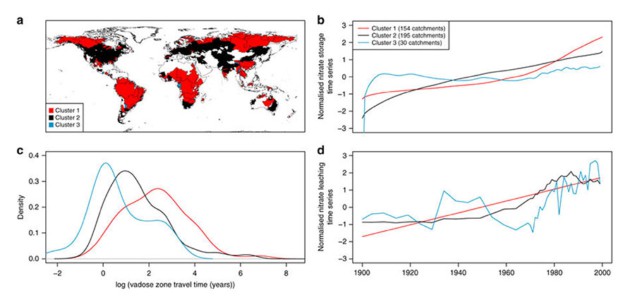
UK hydrogeologists have identified the unsaturated zone, which sits above the water table, to be a major store of nitrate, especially in well-established agricultural regions. The result is a lag potentially spanning decades between nitrate application and its release into drinking water supplies.
Matthew Ascott and colleagues at the British Geological Survey and Lancaster University modelled global nitrate leaching from 1900 to 2000, focusing on the unsaturated zone sandwiched between the soil and groundwater table. They estimated peak global storage of nitrate in the unsaturated zone to be 605–1814 Teragrams (Tg). This could amount to 7–200% of the biologically available nitrogen in soil.
Reactive nitrogen has more than doubled in terrestrial systems since the industrial revolution, largely due to agricultural and industrial intensification. When nitrate enters surface waters eutrophication can result. This can be catastrophic for aquatic ecosystems, reducing oxygen and light availability. Human health is also at risk. Babies are particularly vulnerable to methaemoglobinaemia, a blood disorder that can result from ingesting nitrates; the World Health Organisation recommends a maximum nitrate concentration in drinking water of 50 mg/l.
Traditional nitrogen budgets assume a steady state with no nitrate accumulation over time. Ascott and colleagues’ model, in contrast, indicated that globally nitrate “shows a substantial and continuous increase” in the unsaturated zone.
The team identified three clusters of catchments exhibiting distinct storage behaviours (see image). Cluster 1 saw consistently increasing nitrate storage until 2000, indicative of ongoing development and intensification, as found in Africa, South East Asia and South America. Cluster 2, typical of the US and Europe, exhibited a similar pattern until around 1985, when catchment measures were implemented. Cluster 3 showed no geographical coherence and less predictable storage behaviour. Initially, nitrate storage increased rapidly then plateaued, indicating a shorter travel time through the unsaturated zone.
Although cluster 3 basins would likely respond quickly to changes in catchment management, clusters 1 and 2, which account for a majority of the globe, showed a lag between nitrate entering the system and emerging in springs and extraction sites.
“The time lag between the soil zone and groundwater means that it may take decades for the impact of the change in management to actually be seen in groundwater,” said Ascott. To date, few nitrate pollution studies consider lags in the unsaturated zone. Ascott hopes the study will “provide a step towards integrating this process into policy” on an international scale.



